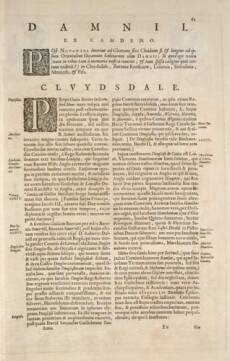Blaeu Atlas of Scotland, 1654
| Field | Content |
|---|---|
| Name: | Blaeu, Joan, 1596-1673 |
| Title: | Damnii; Clvydsdale |
| Pagination: | 61 |
| Zoom view: | Click on the image to view in greater detail |
| 76 / 162 Scroll through pages: 


 | |
Translation of text:
THE DAMNII
FROM CAMDEN. (Section Note)
After the Novantes, further in to the River Glotta or Clyde and a greater distance towards the Eastern Ocean, there once lived the Damnii, if I have any insight (for in matters so remote from our memory and in such deep darkness, who could see with assurance?) in Clydesdale, the Barony of Renfrew, Lennox, Stirling, Menteith, and Fife.
CLYDESDALE (Section Note)Near the source of the Clyde on Crawford Moor, the fact that in wild country peasants have discovered scrapings of gold after heavier rains has long led to hopes of riches, but especially in our days since B. Bulmer has with mighty endeavour undertaken to find a gold mine here. Certainly lapis lazuli is dug up daily with hardly any labour. Crawford Castle, along with the title of Earl of Crawford, was given by King Robert II to James (1) Lindsay, who won great praise for bravery in single combat with the Englishman Baron Welles. The outstanding merits of the Lindsays to their country and their certainly ancient nobility have existed since William Lindsay married one of the heirs of William of Lancaster, Lord of Kendal in England, whose great-great-granddaughter was married into the highly honoured French family of Coucy. [The head of this family, in the time of James III, was created Duke of Montrose for the whole time of his life; the diploma is extant in the register of Scotland; on his death the dukedom perished.]
From its source the Clyde struggles north past the house of Baron Somerville, in the Barony of Somerville [after his death it was sold about 1636 to Lord Robert Dalzell from the Gentlemen of the King’s Bedchamber, who now enjoys the title of Earl of Carnwath], and from the west takes in the Duglas or Douglas Water, named from its blackish and greenish water; it shares its name both with the valley through which it flows, called Douglasdale, and with Douglas Castle in it, which in like manner has imparted it to the family of Douglases. This family, which is certainly very old, achieved its greatest fame after James Douglas was always present, as his closest friend, with unique bravery of spirit and prudence in the most difficult times, with King Robert Bruce as he claimed the kingdom, and the same Robert entrusted his heart to him, to fulfil the vow to convey it to Jerusalem. In memory of him the Douglases inserted a human heart into their shield. From that time it grew into such power and wealth, after David II created William Earl of Douglas, that it roused fear even in the Kings themselves, for at one point it had five Earls, scil. this one of Douglas, of Angus, of Ormond, of Wigtoun, of Moray and of Morton; of them the Earl of Wigtoun by his virtue in war earned the title of Duke of Touraine from Charles VII King of France, and left it to one or two of the Earls of Douglas, who were his heirs. [On the Douglas family see Buchanan on the reign of James II, and other matters pertaining to this.]
Above the confluence of the Douglas and the Clyde is Lanark, the hereditary Sheriffdom of the Hamiltons; they owe their name to Hamilton Castle, which is situated further up on the banks of the Clyde in a fertile and lovely spot, but their origin from England, as they themselves tell, to a certain Englishman surnamed Hampton, who took the side of Robert Bruce and received estates in this area from him. A great increase in their wealth came by the kindness of James III, who gave in marriage his eldest sister, snatched from Boyd, to James Hamilton along with the Earldom of Arran. The increase in honours however came through the Estates of the Kingdom, who declared James Hamilton his grandson by his son, on the death of James V, Governor of Scotland, and he too was greeted by Henry II King of France as Duke of Chatelherault in Poitou; and also through James VI, who created his son John with the new title, not previously used in Scotland, of Marquis of Hamilton.
The Glotta or Clyde from here flows through Bothwell (which boasts of its own Earls: John Ramsay, who had excessive influence, destructive to both him and the King, with James III, and the Hepburns, who have been mentioned previously), and soon in a downward course through Glasgow, at one time an episcopal seat, but long neglected until King William restored it; now archiepiscopal, and the University, which Bishop Turnbull founded in a pious foundation in 1454 when the College was built. This is the most famous market in this area, in a lovely situation, praised for its apple trees, and it has a beautiful bridge resting on nine arches. On it J. Johnston:


